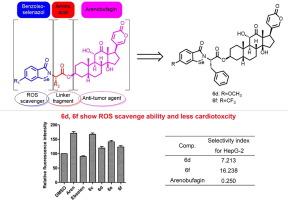Bioorganic & Medicinal Chemistry Letters ( IF 2.7 ) Pub Date : 2018-08-29 , DOI: 10.1016/j.bmcl.2018.08.038 Wen Hou , Zhi-Xing Huang , Hong-Gui Xu , Jing Lin , Dong-Mei Zhang , Qun-Long Peng , Hui Lin , Yi-Qun Chang , Long-Hai Wang , Zhe Yao , Ping-Hua Sun , Wei-Min Chen

|
Arenobufagin is a naturally occurring bufadienolide showing promising antitumor activity accompanied however with apparent cardiac toxicity. Following the recent discovery that oxidative damage possibly be an important cause of the cardiac toxicity of cardenolides, a strategy fusing the antitumor agent arenobufagin with a benzoisoselenazol fragment, a reactive oxygen species (ROS) scavenger, has been developed. Six novel hybrids were synthesized and their ROS scavenging activities as well as their in vitro cytotoxicity against the human hepatocellular carcinoma cell line HepG2, an adriamycin-resistant subline HepG2/ADM, and the human myocardial cell line AC16 were evaluated. The results indicate that the hybrids exhibit various degrees of in vitro ROS scavenging activities, and weaker cytotoxicity than that of arenobufagin against the myocardial cell line AC16. These findings suggest the feasibility of a strategy in which the cardiotoxicity of the potential antitumor agent arenobufagin is reduced.
中文翻译:

槟榔蟾蜍精和苯并异壬基萘唑的杂种降低了槟榔蟾蜍精的心脏毒性
槟榔蟾蜍精是一种天然存在的丁二烯内酯,显示出有希望的抗肿瘤活性,但伴有明显的心脏毒性。在最近发现氧化损伤可能是烯醇内酯心脏毒性的重要原因的最新发现之后,已经开发出将抗肿瘤剂槟榔紫杉醇与苯并异硒酚唑片段(一种活性氧(ROS)清除剂)融合的策略。合成了六种新的杂种,评估了它们的ROS清除活性以及对人肝癌细胞系HepG2,抗阿霉素亚系HepG2 / ADM和人心肌细胞AC16的体外细胞毒性。结果表明杂种表现出不同程度的体外ROS清除活性,并且比槟榔紫胶对心肌细胞AC16的细胞毒性弱。这些发现表明,减少潜在抗肿瘤剂阿诺布丁的心脏毒性的策略的可行性。



























 京公网安备 11010802027423号
京公网安备 11010802027423号